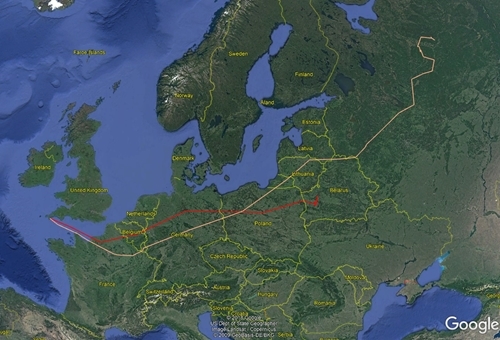A few weeks ago, we posted a blog about our annual field-trip to Cornwall where the Woodcock Watch team are running a long-term mark-and-recapture study. As well as ringing woodcock, a small sample were tagged with GPS loggers: small tracking devices that record their location but need to be recovered to access the data stored on board. We have been deploying these tags since 2016 and, this winter, have recovered seven of those deployed in previous years. This is one of a series of blogs describing the results these tags have provided (the previous blog can be found here.

Tags 12816 (Red) and 12817 (Salmon)
Despite the title of this blog, both of these woodcock made it back to Cornwall. We could not have recovered their GPS-loggers if they had not. Unfortunately, however, the tags only managed to record their spring migrations. Both birds were tagged in 2016, with our first batch of GPS-loggers, and the batteries were not as efficient as those used in more recent models.
Red left Cornwall on the 2nd March, Salmon on the 21st. Both woodcock began on very similar trajectories, crossing into France at the same location and passing through the same regions of France, Germany and Poland. But here the two diverge – while Red settles in a Belarussian breeding site, Salmon travelled an additional 1,500 km to a site in Arkhangelsk Oblast.
It may appear as though their departure dates don’t match their final destinations: Salmon left later even though s/he had the greater distance to travel. One explanation may be that there are differences in departure dates between sexes. Frustratingly the biometrics of these individuals proved inconclusive*, so we can’t definitely prove or disprove this suggestion yet. Another potential explanation for these differences might be their respective breeding seasons – breeding will begin earlier at more southerly latitudes, giving the Belarussian Red a greater incentive to leave Cornwall before Salmon.
* Sex is determined by the ratio of tail length to bill length, but more than half of adult birds fall in a grey area where this method does not provide definitive results.